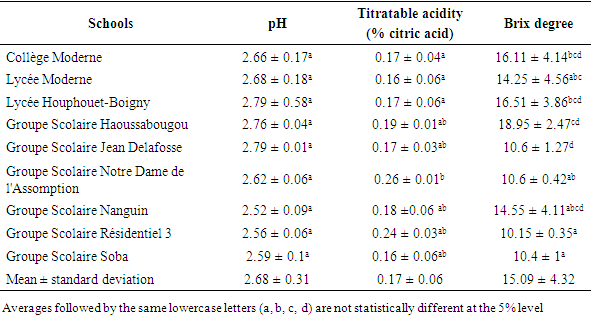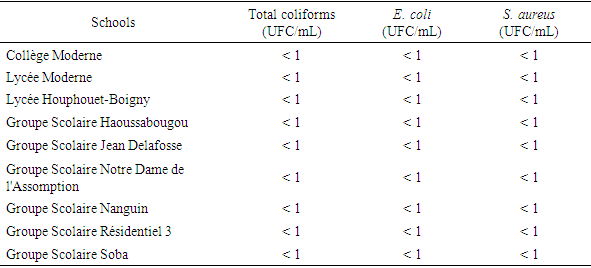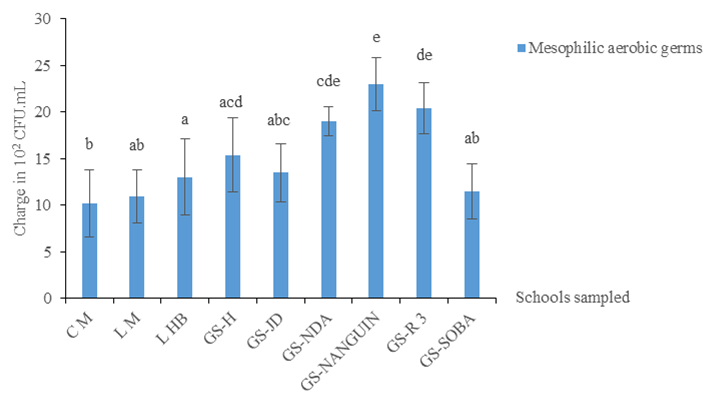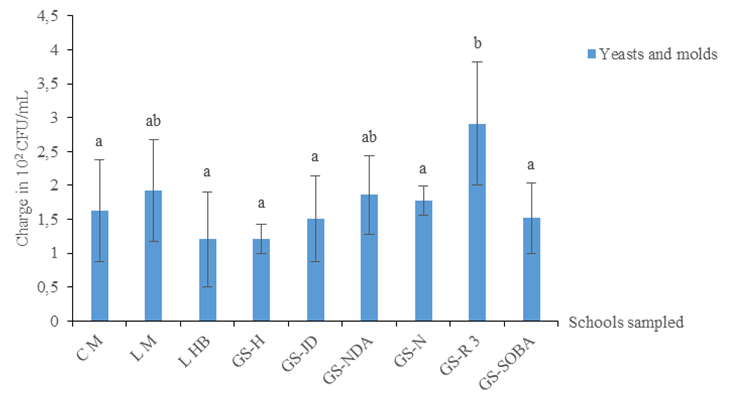-
Paper Information
- Paper Submission
-
Journal Information
- About This Journal
- Editorial Board
- Current Issue
- Archive
- Author Guidelines
- Contact Us
Food and Public Health
p-ISSN: 2162-9412 e-ISSN: 2162-8440
2022; 12(2): 56-61
doi:10.5923/j.fph.20221202.03
Received: Aug. 20, 2022; Accepted: Sep. 18, 2022; Published: Dec. 6, 2022

Evaluation of the Hygienic Quality of “Bissap” Juice (Hibiscus sabdariffa) Sold in the Markets of Primary and Secondary Schools in Korhogo (Côte d’Ivoire)
Katinan Rémi Coulibaly1, Konan Mathurin Yao1, Ollo Kambire1, Kouadio Ernest Koffi2, Nogbou Emmanuel Assidjo3
1Unité de formation et de Recherche des Sciences Biologiques, Département de Biochimie-Génétique, Université Peleforo Gon Coulibaly, Korhogo, BP 1328, Korhogo, Côte d’Ivoire
2Laboratoire de Biochimie et Sciences des Aliments (LaBSA), Unité de formation et de Recherche de Biosciences, Université Félix Houphouët Boigny, Abidjan, 22 BP 582 Abidjan 22, Côte d’Ivoire
3Laboratoire des Procédés Industriels de Synthèse, de l’Environnement et des Energies Nouvelles (LAPISEN), Institut National Polytechnique Houphouët Boigny, Yamoussoukro, BP 1313 Yamoussoukro, Côte d’Ivoire
Correspondence to: Katinan Rémi Coulibaly, Unité de formation et de Recherche des Sciences Biologiques, Département de Biochimie-Génétique, Université Peleforo Gon Coulibaly, Korhogo, BP 1328, Korhogo, Côte d’Ivoire.
| Email: |  |
Copyright © 2022 The Author(s). Published by Scientific & Academic Publishing.
This work is licensed under the Creative Commons Attribution International License (CC BY).
http://creativecommons.org/licenses/by/4.0/

Bissap juice, obtained by decoction of Hibiscus sabdariffa calyxes, is a non-alcoholic drink consumed by populations in sub-Saharan Africa in general, and particularly by students of primary and secondary schools in Korhogo city. This refreshing drink, produced under hygienic conditions beyond any official control, could constitute a public health problem. This study was carried out to assess the health quality of bissap juice consumed by students. Physicochemical analysis revealed that bissap juice is very acidic (pH varies between 2.52 ± 0.09 and 2.79 ± 0.58). This acidity would protect the bissap against the proliferation of certain pathogenic germs. Indeed, microbiological analysis revealed that these juices contain less than 1 CFU/mL of total coliforms, Escherichia coli, Staphylococcus aureus. For these sprouts, these juices would be of acceptable sanitary quality. However, this acidity of the juices promotes the proliferation of yeasts and molds with an average value which varies between 1.21×102 ± 0.22 CFU/mL and 2.91×102 ± 0.91 CFU/mL. The addition of sugar makes bissap a refreshing sweet drink with an average Brix degree value ranging between 10.15 ± 0.35 and 18.95 ± 2.47. This sugar constitutes a substrate which would promote the proliferation of yeasts and molds. These microorganisms could release secondary metabolites into bissap juice which could have an adverse effect on the health of consumers. It is therefore necessary to characterize and identify the different fungal flora as well as their possible pathogenic metabolites in perspective, in order to assess the health risk incurred by the consumer.
Keywords: Hibiscus sabdariffa, Non-alcoholic drink, Hygienic quality, Korhogo
Cite this paper: Katinan Rémi Coulibaly, Konan Mathurin Yao, Ollo Kambire, Kouadio Ernest Koffi, Nogbou Emmanuel Assidjo, Evaluation of the Hygienic Quality of “Bissap” Juice (Hibiscus sabdariffa) Sold in the Markets of Primary and Secondary Schools in Korhogo (Côte d’Ivoire), Food and Public Health, Vol. 12 No. 2, 2022, pp. 56-61. doi: 10.5923/j.fph.20221202.03.
Article Outline
1. Introduction
- Population growth in sub-Saharan African countries has increased significantly over the last two decades [1,2]. For example, the population of Côte d'Ivoire has increased from 16454660 inhabitants in 2000 to 26378275 in 2020 [3]. Also, the agglomerations are experiencing significant development and population growth.Working people are often away from their homes at meal times during the day. They resort to street food. High consumer demand has led to the development of this activity [4,5]. Therefore, schoolchildren, unable to go home to eat or refresh themselves, resort to street food sold either around schools or the streets leading to them, or in markets within the schools.Vendors usually offer snacks and soft drinks [6]. The latter usually consist of water, flavoured and sweetened juices. These juices are made from plants or synthetic flavours. For example, gnamankoudji juice is obtained from the rhizomes of Zingiber officinale, tomi juice from the fruit of the tamarind tree (Tamarindus indica), and bissap juice from the dried calyxes of Hibiscus sabdariffa. Schoolchildren in Korhogo use this type of food during the school year. The sale of food in the school markets in Korhogo is mainly the activity of women. Bissap juice is sold by almost all the women vendors, making it the most popular soft drink among schoolchildren. Hibiscus sabdariffa calyxes contain minerals, organic acids, antioxidants, proteins, lipids, carbohydrates, vitamin C [7-10]. Also, bissap juice would constitute a favourable environment for the microorganisms growth. The food offered to students is cooked in an informal setting and in hygienic conditions that escape to any official control. As these vendors have very little knowledge of catering, there is a risk of illness linked to the consumption of the food they offer to pupils. It seems necessary to evaluate the sanitary quality of these foods, mainly bissap juice, in order to preserve the health of the pupils.
2. Materials and Methods
2.1. Study Matrix
- The study matrix is bissap juice, obtained from Hibiscus sabdariffa calyxes, sold in the markets of primary and secondary schools in the city of Korhogo (Figure 1).
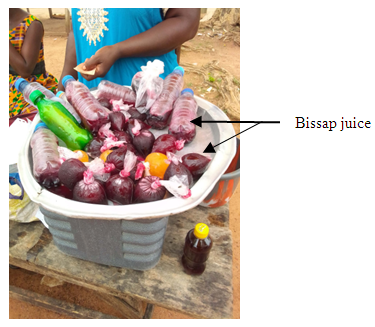 | Figure 1. Bissap juice packaged in plastic bottle and sachet |
2.2. Method of Making Bissap Juice
- The process for obtaining bissap juice is summarized in (Figure 2) according to the results of the survey from women vendors.
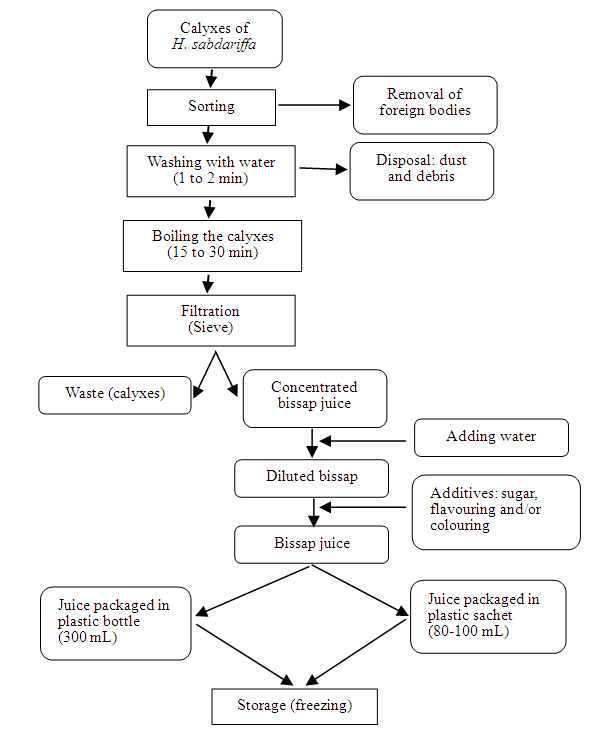 | Figure 2. Empirical diagram of the manufacture of bissap juice by decoction (field survey) |
2.3. Sampling
- Bissap juice was randomly collected from vendors in 3 (three) secondary schools and 6 (six) primary schools across Korhogo. A total of 30 (thirty) women vendors were involved in this study. A sample was taken (purchased) from each of them by putting ourselves in the conditions of a student at each visit. A total of three visits was made to each vendor, at least one week apart, for a total of 90 (ninety) samples. The samples taken at each visit were transported aseptically in coolers containing ice condensers and immediately transported to the laboratory for analysis.
2.4. Physicochemical Analysis
2.4.1. pH Determination
- The samples pH was determined using a Hanna Instruments HI9124 digital pH meter. The measurements were carried out according to the manufacturer's recommendations.
2.4.2. Titratable Acidity
- The bissap juice titratable acidity was determined according to the ISO 750: 1998 standard.
2.4.3. Brix Degree
- The Brix degree was determined using an ATAGO digital refractometer, PAL-α (AT-3840). After calibration, using a pipette, a few drops of the sample were applied to the measuring well and then the start key was pressed to read the Brix value, according to the manufacturer's instructions.
2.5. Microbiological Analysis
- The microbiological analysis were preceded by a successive decimal dilution of each sample taken from each vendor in accordance with NF V08-010 standard. The enumeration of the total mesophilic aerobic flora was carried out on Plate Count Agar (PCA), at 30°C for 72 hours according to the NF/ISO 4833: 2003 standard. Total coliforms were isolated and enumerated on Lactose Bile Agar with Cristal Violet and Neutral Red (VRBL) at 30°C for 24 hours according to NF/ISO 4832: 2006 standard. Rapid'E. coli 2 agar was used to isolate and enumerate Escherichia coli at 44 °C for 24 to 48 hours according to the NF/ISO16140: 2013 standard. Baird-Parker agar with potassium tellurite egg yolk and 0.2% Sulfamethazine was used to isolate and enumerate Staphylococcus aureus at 37 °C for 48 hours according to NF/ISO 6888: 2004 standard. Yeasts and moulds were isolated and enumerated on Sabouraud Chloramphenicol agar at 25°C for 5 days according to the NF/ISO 16212: 2011 standard. All of these media were prepared according to the manufacturer's instructions. Each decimal dilution of each sample was inoculated in duplicate.
2.6. Enumeration of Microorganisms
- Germ count calculations were performed according to ISO-7218 (2007) which determines the number N of colonies according to the following formula:
 | (1) |
2.7. Statistical Analysis
- All data were analysed using one-way analysis of variance (ANOVA) with significance level set at P < 0.05.
3. Results and Discussion
3.1. Physicochemical Characteristics
- The analysis carried out on the different bissap samples revealed that the average pH values vary between 2.52 ± 0.09 and 2.79 ± 0.58. No significant difference (p < 0.05) is statistically observed between samples from the different schools (Table 1). These values are in line with the Tanzanian standard (TZS 585: 2011) for non-carbonated soft drinks (pH: 2.5 – 4.5). These results are close to those obtained by [11] and [12], respectively 2.5 ± 0.1 and between 2.67 and 2.77.
|
3.2. Microbiological Caracteristics
- Table 2 shows that all bissap samples analysed contained less than 1 CFU/mL of total coliforms, Escherichia coli and Staphylococcus aureus. For these microorganisms, the consumption of these juices would not constitute a health risk for the consumer. These results are different from those observed by [12] whose work revealed the presence of S. aureus and E. coli in the juices. The results herein could be explained by the heat treatment of the calyxes of H. sabdariffa (figure 2), but also by the low pH (2.52 ± 0.09 and 2.79 ± 0.58) which is a growth inhibiting factor for most of the main aerobic mesophilic germs found in food [15]. Indeed, most pathogenic bacteria are neutrophiles (pH between 5.4 and 8.0) [16].
|
4. Conclusions
- This study shows that the bissap juice sold in schools in the city of Korhogo is very acidic. This low pH prevents the proliferation of pathogenic microorganisms and protects the health of consumers. However, this acidity promotes the growth of yeasts and moulds which constitute a danger to the consumer health. The use of potable water and the observance of good hygiene and production practices would help to reduce the fungal load of bissap juice. Isolation and identification of yeasts and moulds, as well as their various possible pathogenic metabolites, should be carried out with a view to the risk of illness to the consumer.
ACKNOWLEDGEMENTS
- We acknowledge the Korhogo Regional Directorate of National Education Ministry for providing administrative services for this study.
 Abstract
Abstract Reference
Reference Full-Text PDF
Full-Text PDF Full-text HTML
Full-text HTML